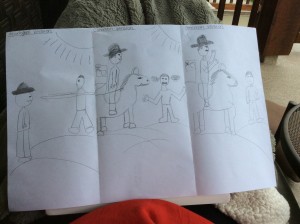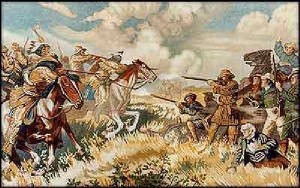Guiding questions p 197-201
1) Why did MacDonald develop the National Policy? He developed the National Policy because he needed a political platform to convince all Canadians of his ideas.
2)List and explain each of the three parts of the National Policy In each case, state why MacDonald thought it was important for the future of Canada – a system of protective tariffs, increased immigration, and the CPR. The protective tariffs was when the taxes would be raised from 15% to 17.5-35%. MacDonald did this because he wanted Canadians to buy less goods from America and instead buy more in Canada to benefit the Canadas economy. The CPR was the third part of the National Policy and MacDonald thought that it was important to build it because they would then have a quick way to transfer the army Also, it would help with the trading of goods within Canada and for people to travel across Canada efficiently.
3) Who did MacDonald get to invest in the CPR and what were their backgrounds? George Stephen, president of the Bank of Montreal, Donald Smith of the Hudson’s Bay Company, and James J. Hill. they had invested $100 000 to St. Paul and Pacific Railway. Within four years, they had made a profit of $17 million.
4) What did MacDonald promise the Syndicate? Macdonald offered $25 million in cash, a land grant of 25 million acres, and a monopoly west of Lake Superior for 20 years.
5) In order to get the benefits from the Government, what did the Syndicate have to do? CPR Syndicate was to complete the railway in 10 years.
6) What did the Syndicate do immediately upon being given the railway contract and why? the CPR Syndicate changed the planned route of the railway. Because the northern Prairies was good farmland, land speculators moved into the area. The Syndicate wanted to be in charge of the big project and the land the railway would cross. To do this they had to move the line 300 km south where there were no speculators. Now the CPR was in charge of the location of railway stations and towns.
7) Why was William Van Horne hired as the new manager of the CPR in 1881? The Syndicate needed a new general manager for the railway, they need someone with drive and high energy so William Van Horne seemed like the right person.
8) Describe the achievements of Van Horne’s management. Van Horne’s arrival quickly energized the CPR – Van Hornoe brought drive and energy that made him work harder on his construction. He was able to have 800 km laid in 1882 and another 800 km the following year. With Van Horne in charge, the CPR could complete the railway in the 10 years given.
9) What problem did the railway face in 1883 and what was the solution? The company was running out of money, The thing costing the most money and most difficult to build had no yet be built in British Columbia. George Stephen and Donald Smith each pledged their entire personal fortunes to provide cash for construction that still wasent enough. The Canadian government passed a bill that provided another $22.5 million for the railway. Van Horne began cutting expenses, but they still needed more money. By the end of 1884,the CPR was almost out of money.
10) Where did the CPR enter into BC? Because of the CPR money troubles, the railway entering BC had to go through the Kicking Horse Pass which was further to the south instead of the Yellowhead Pass.
11) In 1867, why do you think the coast of BC required fewer days to get to from Ottawa than the interior of BC? I think that it required less time because you were able to go all the way around North America by sea which was still quicker than traveling over land.


